By Nicki Richesin, The Children’s Book Review
Published: November 15, 2012
It’s a great treat to have Lisa Catherine Harper guest-posting today about her profound love of graphic novels. Lisa is the author of the fascinating, award-winning memoir, A Double Life, Discovering Motherhood and co-editor, with Caroline Grant, of the forthcoming The Cassoulet Saved our Marriage: True Tales of Food, Family, and How We Learn to Eat. Her new anthology promises to be an engrossing read for parents. If you haven’t attempted reading graphic novels yet, Lisa makes a very convincing argument to give them a try!
I’m the writer in the family, the compulsive reader, the one who takes the kids to the library and the bookstore. I love literature, and language, and poetry, and the classics, and the smell of a new book and all that literary stuff that college professors profess about (I’ve been one of those, too). My husband is an Audible addict and a visual artist (he works in feature animation); he loves technology and pop culture; and even though he had no idea who Emily Dickinson was, I married him anyway.
For a long time, we had an unspoken agreement: In our family, I was the book person. Sure, we both read to the kids and had favorite picture books and a shared affection for books on tape and a certain boy wizard, but the driving force behind the kids’ early literacy? That was me.
But families evolve, and one of the things I didn’t predict was just how much my husband’s interests would influence our family’s reading life. Because here’s the thing: my husband’s love of visual media is second only to his love of story. And guess what? Art + Story = Graphic Novel.
It wasn’t that I disapproved of the form. I just didn’t know much about it. But as our son and daughter branched out from picture books, their father brought home copies of his favorite graphic novels and wedged them into the bedtime story routine. I was aware of this behavior, tolerated it, even. I didn’t have much of an opinion until one afternoon when I spied my then-five-year-old son, hanging upside down off the living room chair compulsively reading a story about a space-traveling mouse. Then I took notice: one of these books led to another, and another; suddenly we had stacks of vividly illustrated volumes piled under our coffee table like fetish objects; they littered the shelves in my son’s bedroom, were slipped in the back seat pocket of the car. Our son and daughter waited for the new volume in a favorite series the way I imagine 19th century readers waited for the next installment of Great Expectations.
Five Reasons to Love Graphic Novels
So, yes, I’m the bandwagon jumper. But I also have the convert’s fervor, and now I am here to count five ways:
1. Graphic novels are books. They have words in them. If you’re reading a graphic novel, you’re reading. All that daydreaming and internal conversation that happens when you read a novel or a nonfiction book about, say, the Titanic–that happens with graphic novels, too.
2. Graphic novels tell great stories. They’re full of adventure, dialogue, inventive characters, dramatic plots. The stories make you think, feel, and speculate. And for all their intergalactic travel and mysterious portals, many of the ones we love best have an ordinary human child at the center of a deeply human plot: she’s trying to save a friend, he’s trying get home, a mother needs rescuing. I often think these books do the work of classic fairy tales: they offer a vividly imagined space where kids can confront their deepest fears and insecurities.
3. Graphic novels promote visual literacy. Does anyone still need to be told this is a crucial 21st century skill? It takes a specific skill set to decode and interpret the sometimes subtle interplay of words and pictures in a graphic novel. They’re actually not that easy to read. The relationship between art and text asks a reader to slow down, think, and problem solve. And also: why should the youngest readers get all the great art?
4. Graphic novels can give girls freedom. In many of the graphic novels we bring into the house, there’s no shortage of adventure-loving, quest-seeking girls. This makes them attractive to our 10-year-old-daughter who has always had a thing for girl-centered, plot-driven, other-world stories. Our son is as compelled by Nancy Drew Vampire Slayer and Zita the Space Girl as he is by Bilbo Baggins and Odysseus. If he’s learning that girls’ adventures are just as exciting as boys’, well that’s good for everyone.
5. Graphic novels celebrate the book-as-object. If you’re reading this, you probably already love books. You probably love the way a page feels, and browse the stacks of your local library, and appreciate the art of a perfect binding or a well-chosen typeface. You probably want your kids to appreciate books, too—not just what’s printed on the pages, but the actual object made of paper, ink, glue, and boards. A graphic novel is the quintessential kids book-as-art. Our son protects the pages of his Tintins like they’re Tinterettos. For him, these books are collectibles; they have value in and of themselves.
Five Graphic Novels to Love
If you have a son over the age of 5, you’re probably familiar with the terrific series by Dav Pilkey and Herge. In our family, these are essential parts of childhood. But there’s a lot more out there. These five have earned their place among our family’s most loved books.
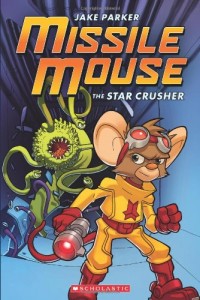 Missile Mouse
Missile Mouse
By Jake Parker
This series follows the adventures of a space mouse secret agent as he tries to save the galaxy. I know, it makes no sense. But kids love this character (maybe in the same way I loved Mighty Mouse?). There’s something utterly endearing about Parker’s bright, fluid, cartoony illustrations, the action-packed sequences, and the crazy gadgetry. MM is funny but it’s his rebellious, loner, go-it-alone attitude that’s most compelling. As he rockets through galaxies and future science, Missile Mouse breaks a lot of rules and takes a lot of risks, which makes him, ironically, sort of human. 2 Volumes.
Ages 8-12 | Publisher: Scholastic | January 1, 2010
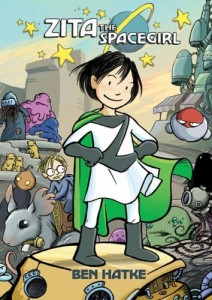 Zita the Space Girl
Zita the Space Girl
By Ben Hatke
When the adorable, resourceful Zita accidently opens a portal, she’s forced to travel to an alternate universe in order to save her friend. There’s an ominous Dickensian class struggle in the world she enters, which is on the brink of apocalypse, and a bit of the Wizard of Oz as she picks up a crew of bots and fantasy animals in her journey. In this wildly imagined and visually compelling setting, Zita morphs from little girl to intrepid hero. Hatke keeps Zita and her quest at the center of this sweet, redemptive tale, which is as vividly and whimsically drawn as it is imagined. 2 Volumes.
Ages 8-12 | Publisher: First Second | February 1, 2011
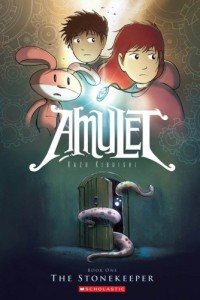 Amulet
Amulet
Kibuishi is a rock star. His series has entered my kids’ imaginations so completely that my son is on a first name basis with “Kazu” and the kids nearly come to blows over who gets to read each new volume first. This series begins with a devastating family tragedy, movingly rendered in Kibuishi’s moody, articulate, graceful paintings. (Suffice to say that although both kids took it in stride, I was in tears by page 10.) When the family moves to an old house to start a new life, Emily discovers a magic amulet, their mother is captured by giant sucking, tentacled monster, and they’re all transported to an alternate universe. As Emily leads her brother on an epic quest to save her mother, they enter a world populated by robots and elves and mentored by a pink robot rabbit. No matter how wild the world gets, the children remain familiar and ordinary, their quest frighteningly real. The depth of the world, the evocative, haunting illustrations, and the story’s emotional truth are what have made this thrilling series a classic. We’ve given these books series to half a dozen other kids, boys and girls, ages 7-10. They all go nuts for it. 5 volumes.
Ages 8-12 | Publisher: Scholastic | January 1, 2008
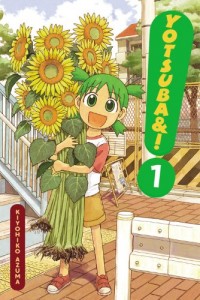 Yotsuba
Yotsuba
Yotsuba is an irrepressible, green-haired school-aged girl—a Japanese cross between Ramona Quimby and Dennis the Menace. Her humor and energy and general naivete about the world cause all sorts of mischief. There’s some implication that she might be an alien, but these character-driven stories are set firmly in the real world. Each volume contains several fast-paced, slice-of-life stories, and the all-ages Manga style illustrations are totally charming. 11 Volumes.
Ages 8-12 | Publisher: Yen Press | September 15, 2009
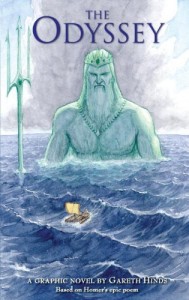 The Odyssey
The Odyssey
By Gareth Hinds
This was easily the best read of the summer for me. And I don’t just mean just the best book that I read to my kids, but the best book I read, full stop. A long, sophisticated, extremely faithful adaptation of the Homer’s epic, Hinds’ book has all the energy, drama, and heroic quest of the original poem. The watercolor and pencil illustrations are glorious and gory, the narration and dialogue resonant. It’s all here: laestrygonians and cyclops, Odyssues’s heroic and heroically flawed nature, his profound fatigue and longing for home, the petty, powerful interfering gods. Hinds’ masterpiece captures perfectly the historical, human, and otherworldly drama of Odysseus’s adventures.
Ages 12-17 | Publisher: Candlewick Press | October 12, 2010
Nicki Richesin is the author and editor of four anthologies; Crush, What I Would Tell Her, Because I Love Her, and The May Queen. She is the San Francisco correspondent for Du Jour and a frequent contributor to Sunset, The Horn Book, 7×7, The Huffington Post, and Daily Candy. Find her online at https://nickirichesin.com/.

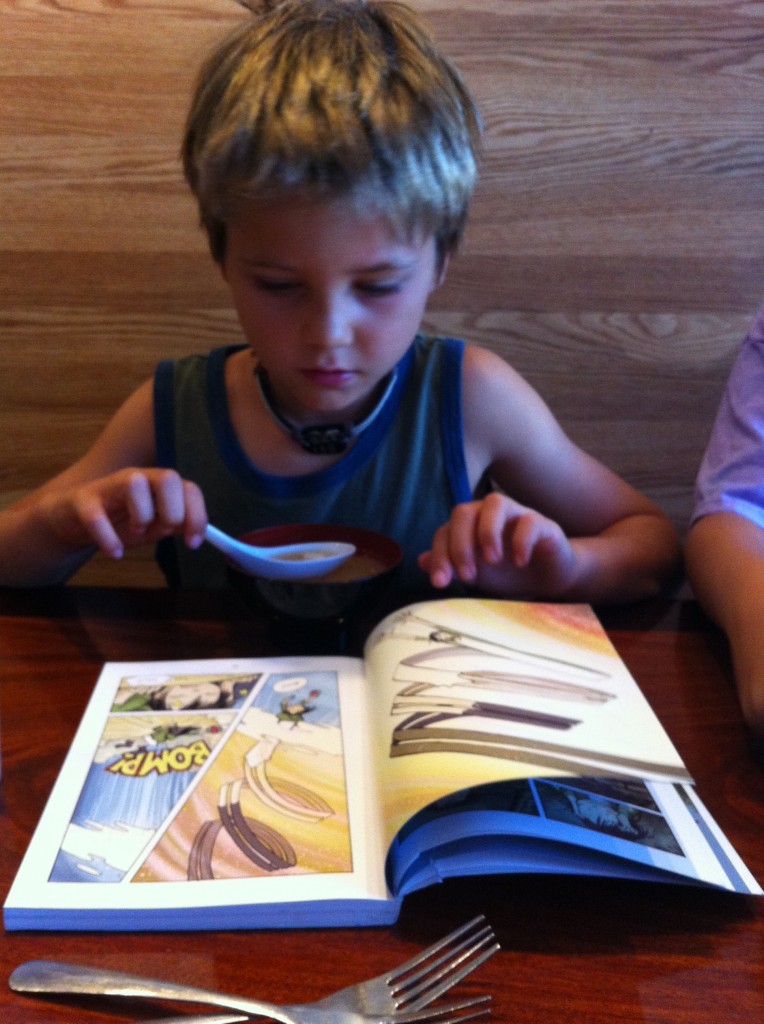
3 Comments
Ahh, so true! My third-grade-previously-non-reading-son just became captivated by the Bone series, and has been staying up late reading them every night for two weeks. The graphics are spectacular and the story is complex. (Make sure to get the colored version of the books, the black-and-white version loses so much).
Great reviews! Just curious if the age ranges correlate to reading level or what you think the kids can handle? My son’s 5 (can’t read yet) and I’ve read both the Zita books to him (as well as the first few Bone volumes and a lot of Tiny Titans, Superman Family Adventures and Marvel’s recent Oz adaptations). Out of all your recommendations it sounds like Amulet and definitely the Odyssey will have to wait a year or two more.
Chris, yes, my son read Amulet at 6, and Odyssey definitely skews older–even if you’re just reading it to your kid. It’s the Odyssey, so war, violence, and monsters are inherent to the story. It’s not gratuitious, but it is graphic. Missile Mouse is a great one for younger kids, and Kabuishi’s Explorer and Mystery Box series are also good for the set who likes Zita, Tiny Titans,etc. Lisa